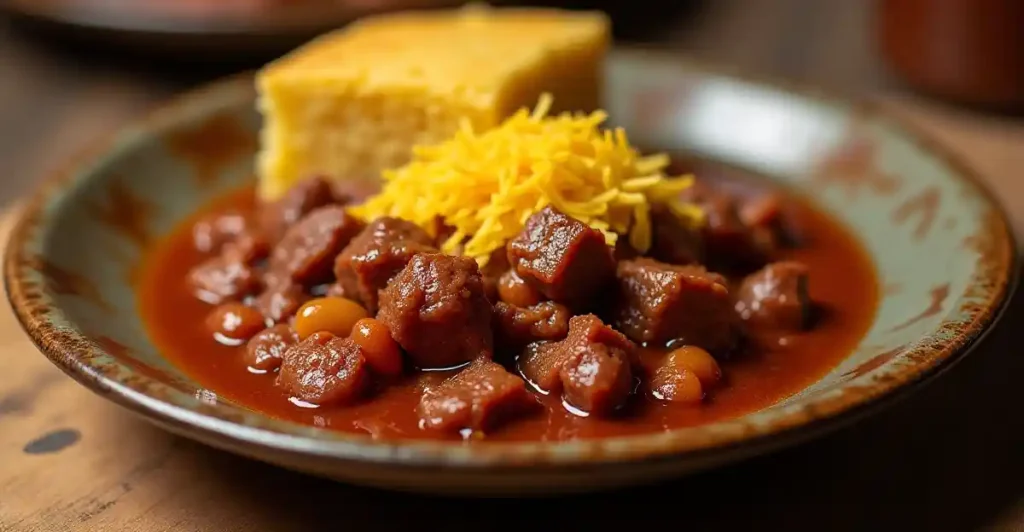What Is the Best Meat for Chili?
Why Meat Choice Matters in Chili
The type of meat you choose for chili has a significant impact on its flavor, texture, and overall appeal. Whether you prefer a rich and hearty Texas-style chili or a bean-based version with a variety of proteins, the meat can make or break the dish. Each type of meat brings its unique qualities, from the juiciness of ground beef to the deep flavors of slow-cooked chuck roast.
Balancing Flavor and Texture
When selecting meat for chili, it’s essential to balance flavor and texture. The right meat should complement the spices and other ingredients while providing enough richness to create a satisfying meal. Additionally, some meats hold up better to the long cooking process, ensuring tender bites in every spoonful.
Classic Meat Choices
Ground Beef
Ground beef is a staple for many chili recipes, and for good reason. Its versatility and rich flavor make it an excellent base for traditional chili.
Why Choose Ground Beef?
- Flavor: The fat content in ground beef enhances the dish’s richness, blending well with chili spices.
- Texture: Ground beef creates a uniform consistency, perfect for those who prefer smooth, hearty chili.
- Convenience: It cooks quickly and absorbs the flavors of other ingredients effectively.
Best Ground Beef to Use:
- Opt for 80/20 ground beef (80% lean, 20% fat) for a good balance of flavor and tenderness.
- If you prefer a leaner option, 90/10 works, but consider adding a bit of olive oil to prevent dryness.
Chuck Roast or Brisket
For a more elevated and robust chili, cuts like chuck roast or brisket are hard to beat. These meats are ideal for slow-cooked, chunky chili recipes.
Why Choose Chuck Roast or Brisket?
- Flavor Depth: These cuts are rich in marbling, which breaks down during cooking, infusing the chili with incredible flavor.
- Tender Texture: Slow cooking transforms tough cuts into melt-in-your-mouth pieces.
- Rustic Appeal: Perfect for Texas-style chili, where chunks of meat take center stage.
Tips for Preparation:
- Cut the meat into bite-sized cubes for even cooking.
- Brown the meat before simmering to lock in juices and add depth to the chili.
Pork Options
Pork is an underrated but flavorful choice for chili, offering a slightly sweeter and milder taste compared to beef.
Popular Pork Cuts for Chili:
- Ground Pork: Similar to ground beef, it provides a smooth texture and absorbs spices well.
- Pork Shoulder: Ideal for slow-cooked chili, as the fat content keeps the meat moist.
- Chorizo: Adds a spicy, smoky kick to any chili recipe.
Pork works particularly well in bean-based chili, where its sweetness balances the earthy flavors of legumes.
Creative Alternatives

Chicken and Turkey
For a lighter alternative to beef or pork, chicken and turkey are excellent options for chili. These lean proteins offer a milder base that pairs well with bold spices and other ingredients.
Why Choose Chicken or Turkey?
- Lean and Healthy: Lower in fat, making it ideal for those seeking a lighter dish.
- Flavor Versatility: Takes on the flavors of spices, making it adaptable for various chili styles.
- Quick Cooking: Perfect for weeknight dinners when time is limited.
Preparation Tips:
- Use ground chicken or turkey for a smoother chili consistency.
- Opt for dark meat like chicken thighs for added moisture and flavor.
- Add extra fat or oil if using lean turkey to prevent the meat from drying out.
Venison
Venison is a fantastic choice for those looking to add a gamey, robust flavor to their chili. This lean, protein-rich meat is perfect for creating a hearty and unique dish.
Why Choose Venison?
- Distinct Flavor: Its slightly earthy, gamey taste pairs beautifully with smoky and spicy chili ingredients.
- Lean Protein: A great option for those who prefer lower-fat meals.
- Sustainability: Often sourced locally or from hunting, venison is an eco-friendly choice.
Preparation Tips:
- Marinate the meat to enhance its tenderness and reduce the gamey flavor.
- Combine venison with fattier meats like pork for a more balanced texture.
For a deeper dive into venison-based recipes, explore this venison chili guide for inspiration.
Plant-Based Options for a Twist
If you’re catering to vegetarians or simply want a meatless alternative, plant-based proteins can still create a satisfying chili.
Popular Plant-Based Substitutes:
- Lentils or Chickpeas: Offer a hearty texture and blend well with spices.
- Textured Vegetable Protein (TVP): Mimics the consistency of ground meat.
- Mushrooms: Provide an umami-rich flavor and a
meaty texture.
Why Consider Plant-Based Options?
- Health Benefits: Lower in fat and calories while being rich in fiber and nutrients.
- Sustainability: Plant-based proteins have a smaller environmental impact.
- Flavor Absorption: Easily soaks up chili spices and seasonings, making them as flavorful as meat-based versions.
For a balanced chili, you can mix plant-based proteins with beans, tomatoes, and spices to create a hearty, satisfying dish.
Pairing Meat with Chili Styles

Texas Chili
Texas chili, often referred to as “chili con carne,” is all about the meat. This hearty dish typically excludes beans, letting the meat shine as the star ingredient.
Best Meats for Texas Chili:
- Chuck Roast or Brisket: Their marbling and flavor depth are perfect for slow-cooked recipes.
- Ground Beef: A classic option for a smoother texture.
- Venison: Adds a unique, gamey twist for adventurous eaters.
Flavor Pairings:
- Use smoky spices like smoked paprika or chipotle for added depth.
- Pair with toppings like shredded cheese or diced onions to complement the rich meat flavors.
Bean-Based Chili
For chili recipes that include beans, the meat should balance the dish without overpowering the legumes.
Best Meats for Bean-Based Chili:
- Ground Pork or Turkey: Their mild flavors blend seamlessly with beans.
- Chorizo: Adds a smoky, spicy kick that pairs well with pinto or black beans.
- Chicken: A lighter option that complements the earthiness of beans.
Bean-based chili often benefits from a medley of spices like cumin, coriander, and oregano to tie the ingredients together.
Vegetarian-Friendly Chili
If you’re exploring a meatless or plant-based chili, focus on hearty ingredients and bold seasonings.
Plant-Based Protein Suggestions:
- Lentils and Black Beans: Provide a meaty texture and absorb spices well.
- Plant-Based Meat Alternatives: Brands like Beyond Meat or Impossible offer realistic meat textures for chili.
- Mushrooms and Eggplant: Add umami-rich flavors for a satisfying base.
For vegetarian options, add toppings like avocado or tortilla strips for extra flavor and texture. This approach makes vegetarian chili just as exciting as meat-based versions.
Tips for Cooking Meat for Chili
Browning Meat for Flavor
One of the most important steps in making chili is browning the meat before adding it to the pot. This technique develops rich, caramelized flavors that enhance the dish.
How to Brown Meat Properly:
- Heat Your Pan: Use a heavy-bottomed pan, such as a cast-iron skillet, to ensure even browning.
- Avoid Overcrowding: Cook the meat in small batches to allow it to sear properly instead of steaming.
- Don’t Stir Too Much: Let the meat sit for a minute or two before flipping, so it develops a golden crust.
Adding browned meat to your chili creates a deeper, more complex flavor base.
Choosing Fat Content
The fat content of the meat plays a significant role in the texture and richness of chili.
Fat Content Tips:
- Ground Meats: For ground beef or pork, an 80/20 ratio provides the best balance of flavor and texture.
- Leaner Options: If using lean meats like turkey or chicken, consider adding a small amount of oil or mixing in fattier cuts to prevent dryness.
- Skimming Excess Fat: After cooking, skim off excess fat from the pot to avoid a greasy finish.
Selecting the right fat level ensures your chili is both flavorful and satisfying.
Cooking Low and Slow
Chili is a dish that thrives on slow, gradual cooking. This method allows the flavors to meld and the meat to become tender.
Slow Cooking Tips:
- Simmer for Hours: Let the chili cook on low heat for at least 1–2 hours.
- Use a Slow Cooker: For convenience, transfer your chili to a slow cooker and let it cook for 6–8 hours on low.
- Stir Occasionally: Prevent sticking by stirring the chili occasionally, especially if cooking on the stovetop.
For an added layer of complexity, refrigerate the chili overnight and reheat it the next day. The extra time allows the flavors to deepen and develop further.
FAQs
Can You Mix Different Meats in Chili?
Absolutely! Combining different meats can add complexity and richness to your chili. For instance:
- Ground Beef and Chorizo: This pairing adds a smoky, spicy kick to the chili.
- Pork and Chicken: Blending these meats creates a lighter, balanced flavor profile.
- Beef and Venison: This combination offers the perfect mix of hearty and gamey flavors.
When mixing meats, ensure they’re cooked evenly by cutting or grinding them to similar sizes.
What’s the Best Meat for Spicy Chili?
For spicy chili, you’ll want meats that can hold their own against bold, fiery flavors. Options include:
- Chorizo: Its smoky, spiced profile enhances heat without being overwhelmed.
- Chuck Roast: Slow-cooked chunks of beef absorb spices beautifully.
- Ground Turkey: A lean option that pairs well with hot chili peppers.
Pairing spicy meats with cooling toppings like sour cream or shredded cheese can balance the heat.
How Do You Make a Leaner Chili?
To create a leaner chili without sacrificing flavor, try these tips:
- Use ground turkey, chicken, or venison instead of beef or pork.
- Skim off excess fat after browning the meat or while simmering the chili.
- Add extra vegetables like zucchini or bell peppers to reduce the calorie density.
Lean chili can still be hearty and satisfying, especially when paired with bold spices.
Can You Use Leftover Meat for Chili?
Yes, leftover meats are excellent for chili! They’re already cooked, saving time while adding depth of flavor. Examples include:
- Roast Chicken or Turkey: Shred and add during the last 30 minutes of cooking.
- Brisket: Cut into small chunks and simmer until tender.
- Pulled Pork: Adds a smoky sweetness that works well with spicy chili.
Using leftovers also reduces food waste, making it an economical and sustainable choice.
What’s the Best Meat for Chili Competitions?
For chili competitions, bold flavors and tender textures are key. Popular choices include:
- Brisket: Its rich marbling delivers a luxurious texture and flavor.
- Chuck Roast: A classic choice for hearty, competition-level chili.
- Ground Beef and Chorizo Blend: Offers a balance of spice, smoke, and richness.
To stand out, experiment with unique spice blends or unexpected meat combinations, such as mixing venison and pork.